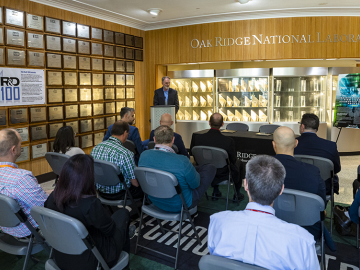
Filter News
Area of Research
- Advanced Manufacturing (4)
- Biological Systems (1)
- Biology and Environment (22)
- Computational Engineering (1)
- Computer Science (5)
- Electricity and Smart Grid (1)
- Energy Science (48)
- Fusion and Fission (15)
- Fusion Energy (8)
- Isotopes (5)
- Materials (76)
- Materials Characterization (1)
- Materials for Computing (3)
- Materials Under Extremes (1)
- National Security (13)
- Neutron Science (27)
- Nuclear Science and Technology (30)
- Nuclear Systems Modeling, Simulation and Validation (1)
- Quantum information Science (3)
- Supercomputing (41)
- Transportation Systems (1)
News Topics
- (-) Big Data (28)
- (-) Biomedical (34)
- (-) Grid (28)
- (-) Materials Science (73)
- (-) Microscopy (20)
- (-) Molten Salt (4)
- (-) Nuclear Energy (69)
- (-) Space Exploration (10)
- 3-D Printing/Advanced Manufacturing (63)
- Advanced Reactors (24)
- Artificial Intelligence (46)
- Bioenergy (44)
- Biology (34)
- Biotechnology (9)
- Buildings (15)
- Chemical Sciences (29)
- Clean Water (12)
- Composites (9)
- Computer Science (97)
- Coronavirus (29)
- Critical Materials (8)
- Cybersecurity (18)
- Education (3)
- Emergency (1)
- Energy Storage (50)
- Environment (91)
- Exascale Computing (20)
- Fossil Energy (2)
- Frontier (22)
- Fusion (27)
- High-Performance Computing (36)
- Hydropower (3)
- Irradiation (2)
- Isotopes (20)
- Machine Learning (28)
- Materials (61)
- Mathematics (4)
- Mercury (4)
- Microelectronics (2)
- Nanotechnology (30)
- National Security (23)
- Neutron Science (88)
- Partnerships (24)
- Physics (33)
- Polymers (13)
- Quantum Computing (12)
- Quantum Science (33)
- Security (8)
- Simulation (29)
- Software (1)
- Summit (35)
- Transportation (45)
Media Contacts

JungHyun Bae is a nuclear scientist studying applications of particles that have some beneficial properties: They are everywhere, they are unlimited, they are safe.

Researchers at the Department of Energy’s Oak Ridge National Laboratory are supporting the grid by improving its smallest building blocks: power modules that act as digital switches.

Tristen Mullins enjoys the hidden side of computers. As a signals processing engineer for ORNL, she tries to uncover information hidden in components used on the nation’s power grid — information that may be susceptible to cyberattacks.

Scientist-inventors from ORNL will present seven new technologies during the Technology Innovation Showcase on Friday, July 14, from 8 a.m.–4 p.m. at the Joint Institute for Computational Sciences on ORNL’s campus.

Like most scientists, Chengping Chai is not content with the surface of things: He wants to probe beyond to learn what’s really going on. But in his case, he is literally building a map of the world beneath, using seismic and acoustic data that reveal when and where the earth moves.

ORNL will team up with six of eight companies that are advancing designs and research and development for fusion power plants with the mission to achieve a pilot-scale demonstration of fusion within a decade.

Nature-based solutions are an effective tool to combat climate change triggered by rising carbon emissions, whether it’s by clearing the skies with bio-based aviation fuels or boosting natural carbon sinks.

As renewable sources of energy such as wind and sun power are being increasingly added to the country’s electrical grid, old-fashioned nuclear energy is also being primed for a resurgence.

A method using augmented reality to create accurate visual representations of ionizing radiation, developed at ORNL, has been licensed by Teletrix, a firm that creates advanced simulation tools to train the nation’s radiation control workforce.

Inspired by one of the mysteries of human perception, an ORNL researcher invented a new way to hide sensitive electric grid information from cyberattack: within a constantly changing color palette.


